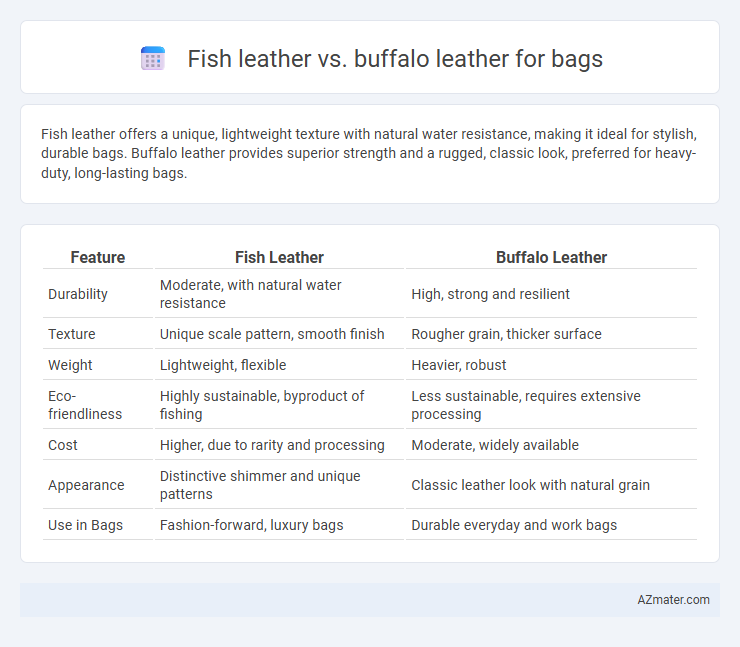Fish leather offers a unique, lightweight texture with natural water resistance, making it ideal for stylish, durable bags. Buffalo leather provides superior strength and a rugged, classic look, preferred for heavy-duty, long-lasting bags.
Table of Comparison
| Feature | Fish Leather | Buffalo Leather |
|---|---|---|
| Durability | Moderate, with natural water resistance | High, strong and resilient |
| Texture | Unique scale pattern, smooth finish | Rougher grain, thicker surface |
| Weight | Lightweight, flexible | Heavier, robust |
| Eco-friendliness | Highly sustainable, byproduct of fishing | Less sustainable, requires extensive processing |
| Cost | Higher, due to rarity and processing | Moderate, widely available |
| Appearance | Distinctive shimmer and unique patterns | Classic leather look with natural grain |
| Use in Bags | Fashion-forward, luxury bags | Durable everyday and work bags |
Introduction to Fish Leather and Buffalo Leather
Fish leather, derived primarily from species like salmon, cod, and perch, offers a sustainable alternative known for its unique scale patterns, lightweight texture, and high durability compared to traditional leathers. Buffalo leather, sourced from the hides of water buffalo, is recognized for its coarse grain, toughness, and natural resistance to wear, making it a favored material for heavy-duty bags. Both leathers provide distinct aesthetic and functional qualities, with fish leather standing out for eco-friendliness and buffalo leather prized for robustness and aging potential.
Origins and Production Processes
Fish leather, originating mainly from Nordic countries and Southeast Asia, is crafted by tanning the skins of fish species like salmon and cod, using eco-friendly vegetable-based tanning methods that preserve its unique scale patterns. Buffalo leather, sourced primarily from India and Southeast Asia, undergoes traditional tanning techniques with chemical or chrome-based agents, resulting in a durable and thick texture ideal for heavy-use bags. The distinct origins and production processes of fish and buffalo leather contribute to their varied aesthetics, sustainability profiles, and functional qualities in bag manufacturing.
Physical Properties and Durability
Fish leather boasts a unique grain structure with fine, dense scales that enhance its flexibility and lightweight nature, making it highly resistant to tearing and abrasion. Buffalo leather offers a coarser texture with greater thickness and natural oils, providing superior water resistance and long-lasting toughness under heavy use. Durability in fish leather suits delicate, stylish bags, while buffalo leather excels in rugged, everyday carry due to its robustness and ability to develop a rich patina over time.
Texture and Aesthetic Appeal
Fish leather offers a unique, exotic texture characterized by natural scale patterns that create an intricate, slightly glossy surface, making it a distinctive choice for fashionable bags. Buffalo leather is known for its robust, coarse grain and matte finish, providing a rugged, durable aesthetic ideal for classic or vintage-style bags. The tactile contrast between the smooth, patterned fish leather and the sturdier, textured buffalo leather allows designers to cater to diverse consumer preferences in luxury and artisanal bag markets.
Environmental Impact and Sustainability
Fish leather offers a more sustainable alternative to buffalo leather due to its utilization of by-products from the fishing industry, significantly reducing waste and resource consumption. It requires less water and energy in processing, resulting in a lower carbon footprint compared to traditional buffalo leather, which involves intensive livestock farming with high greenhouse gas emissions. Fish leather's biodegradability and rapid renewable sourcing make it an environmentally friendly choice for eco-conscious bag manufacturing.
Water Resistance and Maintenance
Fish leather offers superior water resistance compared to buffalo leather due to its dense, tightly packed scales that prevent moisture penetration, making it ideal for bags exposed to wet conditions. Buffalo leather, while durable and tough, is more porous and requires regular conditioning to maintain its water resistance and prevent cracking. Maintenance for fish leather bags typically involves gentle cleaning and minimal conditioning, whereas buffalo leather demands more frequent oiling to sustain its durability and water-repellent properties.
Weight and Flexibility Comparison
Fish leather is significantly lighter than buffalo leather, making it an excellent choice for bags where weight reduction is essential. Its natural fiber structure provides superior flexibility, allowing fish leather bags to conform more easily to various shapes without cracking. In contrast, buffalo leather is heavier and stiffer, offering greater durability but less pliability, which can limit design versatility and comfort in carry.
Cost and Market Availability
Fish leather offers a unique, sustainable alternative to traditional buffalo leather but typically comes at a higher cost due to its specialized tanning process and limited supply. Buffalo leather is more widely available in the market, benefiting from established production channels and lower overall expenses, making it a cost-effective choice for bag manufacturing. The scarcity and artisanal nature of fish leather contribute to its premium pricing, while buffalo leather remains the dominant option in terms of affordability and accessibility.
Ethical Considerations
Fish leather offers a more sustainable alternative to buffalo leather, as it utilizes byproducts from the fishing industry, reducing waste and environmental impact. Buffalo leather typically involves higher greenhouse gas emissions and land use, raising concerns over animal welfare and resource depletion. Choosing fish leather supports eco-friendly practices and aligns with ethical consumerism focused on minimizing harm to animals and ecosystems.
Choosing the Best Leather for Bags
Fish leather offers superior flexibility and unique texture, making it ideal for lightweight, exotic bags with high durability and water resistance. Buffalo leather provides exceptional toughness and a rugged appearance, perfect for heavy-duty bags requiring long-lasting strength and natural grain patterns. Choosing the best leather depends on the desired balance between aesthetics, durability, and specific bag use, with fish leather excelling in eco-friendliness and buffalo leather in robustness.

Infographic: Fish leather vs Buffalo leather for Bag
 azmater.com
azmater.com